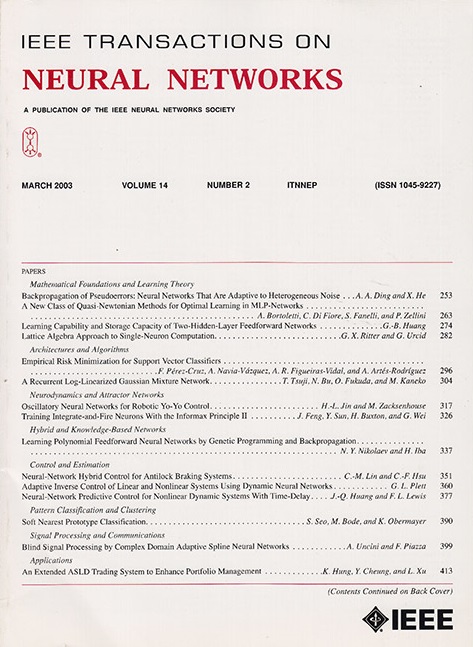唤醒-睡眠巩固学习
IF 8.9
1区 计算机科学
Q1 COMPUTER SCIENCE, ARTIFICIAL INTELLIGENCE
IEEE transactions on neural networks and learning systems
Pub Date : 2024-09-26
DOI:10.1109/TNNLS.2024.3458440
引用次数: 0
摘要
我们提出了一种利用互补学习系统(CLS)理论和人类大脑的觉醒-睡眠阶段来提高深度神经网络(dnn)在持续学习(CL)设置中视觉分类任务的性能的学习策略——醒-睡巩固学习(WSCL)。我们的方法通过不同的觉醒和睡眠阶段之间的同步不断学习。在清醒阶段,模型暴露于感官输入并适应其表征,通过动态参数冻结机制确保稳定性,并将情景记忆存储在短期临时记忆中(类似于海马体中的过程)。在睡眠阶段,训练过程分为非快速眼动(NREM)和快速眼动(REM)阶段。在非快速眼动阶段,利用短期和长期记忆的重放样本巩固模型的突触权重,激活突触可塑性机制,加强重要连接,削弱不重要连接。在快速眼动阶段,模型接触到前所未见的真实视觉感官体验,激活做梦过程,使模型能够探索潜在的特征空间,从而为未来的知识准备突触。我们在四个基准数据集上评估了我们的方法的有效性:CIFAR-10、CIFAR-100、Tiny-ImageNet和FG-ImageNet。在所有情况下,我们的方法都优于基线和先前的工作,在连续的视觉分类任务上产生了显着的性能增益。此外,我们证明了所有处理阶段的有用性以及做梦对实现正向迁移(FWT)的重要性。代码可从https://github.com/perceivelab/wscl获得。本文章由计算机程序翻译,如有差异,请以英文原文为准。
Wake-Sleep Consolidated Learning
We propose wake-sleep consolidated learning (WSCL), a learning strategy leveraging complementary learning system (CLS) theory and the wake-sleep phases of the human brain to improve the performance of deep neural networks (DNNs) for visual classification tasks in continual learning (CL) settings. Our method learns continually via the synchronization between distinct wake and sleep phases. During the wake phase, the model is exposed to sensory input and adapts its representations, ensuring stability through a dynamic parameter freezing mechanism and storing episodic memories in a short-term temporary memory (similar to what happens in the hippocampus). During the sleep phase, the training process is split into nonrapid eye movement (NREM) and rapid eye movement (REM) stages. In the NREM stage, the model’s synaptic weights are consolidated using replayed samples from the short-term and long-term memory and the synaptic plasticity mechanism is activated, strengthening important connections and weakening unimportant ones. In the REM stage, the model is exposed to previously-unseen realistic visual sensory experience, and the dreaming process is activated, which enables the model to explore the potential feature space, thus preparing synapses for future knowledge. We evaluate the effectiveness of our approach on four benchmark datasets: CIFAR-10, CIFAR-100, Tiny-ImageNet, and FG-ImageNet. In all cases, our method outperforms the baselines and prior work, yielding a significant performance gain on continual visual classification tasks. Furthermore, we demonstrate the usefulness of all processing stages and the importance of dreaming to enable positive forward transfer (FWT). The code is available at: https://github.com/perceivelab/wscl .
求助全文
通过发布文献求助,成功后即可免费获取论文全文。
去求助
来源期刊

IEEE transactions on neural networks and learning systems
COMPUTER SCIENCE, ARTIFICIAL INTELLIGENCE-COMPUTER SCIENCE, HARDWARE & ARCHITECTURE
CiteScore
23.80
自引率
9.60%
发文量
2102
审稿时长
3-8 weeks
期刊介绍:
The focus of IEEE Transactions on Neural Networks and Learning Systems is to present scholarly articles discussing the theory, design, and applications of neural networks as well as other learning systems. The journal primarily highlights technical and scientific research in this domain.
 求助内容:
求助内容: 应助结果提醒方式:
应助结果提醒方式:


